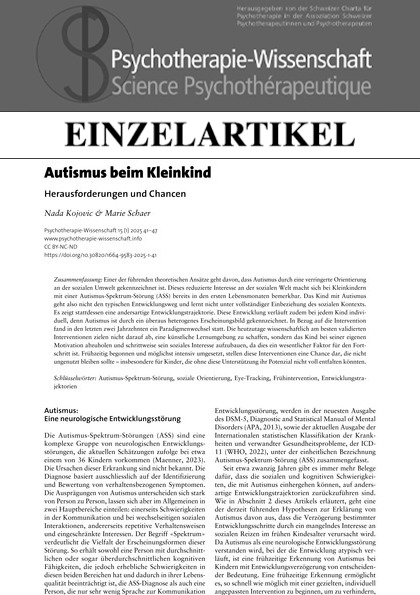Autism in young children
Challenges and opportunities
DOI:
https://doi.org/10.30820/1664-9583-2025-1-41Keywords:
autism spectrum disorder, social orientation, eye-tracking, early intervention, developmental trajectoriesAbstract
One of the leading theoretical approaches assumes that autism is characterized by a reduced orientation towards the social environment. This reduced interest in the social world is already noticeable in young children with an autism spectrum disorder (ASD) in the first few months of life. The child with autism therefore does not follow the typical developmental path and does not learn with the full involvement of the social context. Instead, it shows a different developmental trajectory. This development is also individual for each child, as autism is characterized by an extremely heterogeneous appearance. In terms of intervention, a paradigm shift has taken place over the last two decades. Today’s most scientifically validated interventions do not aim to create an artificial learning environment, but rather to pick up on the child’s own motivation and gradually build up their social interest, as this is a key factor for progress. Started early and implemented as intensively as possible, these interventions represent an opportunity that should not be missed – especially for children who would not be able to develop their full potential without this support.
Downloads
How to Cite
Kojovic, N., & Schaer, M. (2025). Autism in young children: Challenges and opportunities. Psychotherapie-Wissenschaft, 15(1), 41–47. https://doi.org/10.30820/1664-9583-2025-1-41
Issue
Section
Original Work
License

This work is licensed under a Creative Commons Attribution-NonCommercial-NoDerivatives 3.0 Unported License.
This journal provides open access to its content in accordance with the basic premise that the free public availability of research benefits the exchange of knowledge throughout the world.
Authors wishing to publish in this journal agree to the following:
- The author/s retain/s the copyrights and consent/s to initial publication of the work in the journal under a Creative Commons Attribution licence, which allows third parties to use the work by citing the name/s of the author/s and this journal as initial publisher (in accordance with the Creative Commons Attribution-NonCommercial-NoDerivs 3.0 DE-Licence).
- The author/s can enter into additional contracts for the non-exclusive distribution (e.g. publish in a collection or book) of the version published in the journal, if the journal is cited as initial publisher.


